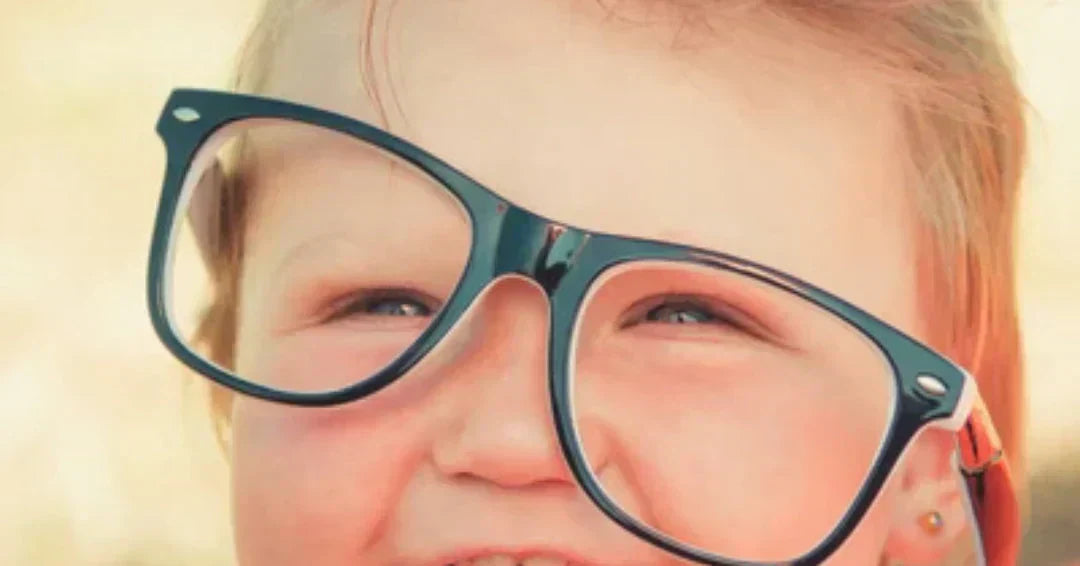"The only thing worse than being blind is having sight but no vision."
-Helen Keller
Identifying potential problems with a child's vision as early as possible is crucial. If kids go for long periods of time with undiagnosed vision problems, this could interfere with their normal development. Visual cues play a huge role in the way babies learn, but if the world around them is blurry, they are unable to accurately process all the stimuli around them. Even a slight impairment can drastically impact a child's ability to learn and progress, not to mention effects on their quality of life. Here are some interesting facts to consider related to eye health in children that impact vision.

Signs of Vision Problems in Children
Kids may not verbally express the fact that they are having difficulty seeing clearly, but there are lots of clues that point to a vision deficit. Children who rub their eyes a lot may be experiencing eye fatigue or strain that can be alleviated with glasses. Kids who complain of headaches and frequently squint their eyes may also have blurry vision. Also, be on the lookout for little ones who hold objects like books or screens close to their faces. This may be a sign of myopia, and the only way they can clearly see is when something is within inches of their eyes. Finally, if you notice that children are covering an eye or tilting their heads when trying to focus, this could signal lazy eye (technically amblyopia) which can be easily corrected with lenses and therapy.

Valuable Information About Vision Health in Children
The most obvious signs of a problem with a child's eyesight can be easily missed. Babies born with an impairment grow into toddlers who are accustomed to seeing the world through a different lens, literally. Behaviors like clumsiness, inability to pay attention for any period of time, and lack of focus on age-appropriate tasks are all signs of potential problems with a child's vision. The good news is that most problems with sight can be easily corrected with a pair of glasses. A trip to the optometrist may be all it takes to diagnose a common condition, find the right lens, and pick out a cute pair of frames. Continue reading for helpful facts about children's vision that can clue you in for when it's time to see an eye doctor.
Childhood Vision Facts Every Parent Needs to Know
It's vital for parents to understand key vision facts concerning their children for several compelling reasons. Alarmingly, about 25% of school-aged children experience vision problems. Often, these issues go unnoticed because children themselves might not recognize or be able to express that they're having difficulty seeing. However, parents who are familiar with typical visual development and the common indicators of vision problems are better equipped to spot potential concerns early on. This early detection and subsequent treatment are paramount. Many vision problems in childhood respond well to treatment, particularly when identified promptly. Conversely, neglecting these issues can unfortunately result in permanent vision impairment in some situations. Continue reading for some helpful facts about childhood vision that shed light on how to identify problems and when to seek treatment.

(1) Babies should have their vision evaluated between 6 and 12 months.
Obviously the vision of babies cannot be tested using eye charts, but optometrists can utilize flashlights, small toys, and other objects to perform the valuation. If no problems are detected, a follow-up examination should happen around age 3 and then again before the child starts school. Sometimes a more serious problem is detected and children are referred to highly trained medical doctors, or ophthalmologists, for a more comprehensive exam.
(2) A thorough eye exam goes beyond establishing 20/20 vision.
Children's vision sharpens gradually in their early years, with most achieving 20/20 vision around the ages of four to six. At this point, their visual acuity is considered "normal," enabling them to see objects clearly at a distance of 20 feet, just as someone with typical eyesight should. However, there are many other visual deficits that are diagnosed and are likely contributors to behavioral and developmental challenges. Glasses, or sometimes even vision therapy, can help correct lazy eye, strabismus (or cross eyes), double vision, and focusing problems. Children with visual impairment have a hard time concentrating on tasks, so it's important to address these issues as early as possible.
(3) Exposure to sunlight is good for eyesight.
Although looking directly at the sun can severely harm young eyes, safe and moderate exposure to sunlight actually provides several advantages for children's vision. For most, sunlight is the main way their bodies produce Vitamin D, a nutrient vital for overall well-being and increasingly linked by research to good eye health. Furthermore, a growing amount of evidence points to a connection between more time spent outdoors in natural light and a reduced chance of children developing nearsightedness. Additionally, exposure to natural light, particularly in the morning, aids in regulating their internal clock, known as the circadian rhythm. This healthy rhythm is crucial for proper sleep, which in turn supports overall health, including the health of their eyes.

(4) Nutrition plays a vital role in the development of healthy vision.
Fueling children's bodies with a colorful array of fruits, vegetables, whole grains, and healthy fats offers a straightforward yet significant advantage for their long-term eye health. Consider Vitamin A, a cornerstone for the retina's development and function – that light-sensitive layer at the back of the eye. It's indispensable for clear vision, particularly in dim light, and helps keep the cornea, the eye's outer surface, healthy. You can find this vital nutrient in foods like carrots, sweet potatoes, spinach, kale, eggs, and fortified options. Then there are Omega-3 Fatty Acids, key building blocks for the retina, especially crucial during infancy and childhood for proper visual development. They also contribute to retinal health and might even ward off dry eye, with sources like salmon, tuna, flaxseeds, chia seeds, and walnuts readily available. Furthermore, Vitamin C acts as a powerful antioxidant, shielding delicate eye structures from damage caused by unstable molecules known as free radicals. It also plays a role in maintaining healthy blood vessels within the eyes, and you can find it in vibrant foods such as oranges, strawberries, bell peppers, broccoli, and kiwi.
(5) Myopia is one of the most common vision impairments in children.
Approximately one in three adolescents experience myopia. Worryingly, the occurrence of nearsightedness in children is on the rise worldwide. Key environmental factors contributing to this increase include more time spent on screens, less time outdoors, and a focus on close-up tasks. Pinpointing myopia in children can be subtle, as they might not recognize their vision isn't sharp or be able to express it. Keep an eye out for these clues: frequent squinting, particularly when looking at distant things like the classroom board or the television; a tendency to sit very close to the TV or hold reading materials and devices right up to their face; complaints about faraway objects appearing blurry or requests to move closer to see them; holding books and toys unusually close; frequent blinking, which can signal eye strain; regular eye rubbing, possibly indicating fatigue; tilting their head, which they might do to find a clearer line of sight; and occasionally covering or closing one eye, an unconscious way to compensate for blurry vision in the other.
(6) Lazy Eye is a common and easily treatable condition in children.
Amblyopia, commonly known as lazy eye, affects an estimated 2% to 5% of children. Identifying and addressing this condition early is vital for the best results, ideally before a child reaches 7 to 10 years old. Since children with lazy eye might not realize they have a vision issue, regular eye exams are the most effective way to detect it. Treatment for children focuses on strengthening the weaker eye and encouraging the brain to rely on it more. The most frequent approach involves eye patching, also called occlusion therapy, where the stronger eye is covered with a patch. This forces the weaker eye to work harder, thereby strengthening its connection to the brain.
(7) Many eye problems in infants will self-correct without medical intervention.
It's understandable for parents to be attentive to their infant's developing vision. While newborns may exhibit some common eye-related behaviors that typically resolve naturally, it's wise to be informed about potential concerns. In the initial months, an infant's eye movements might appear uncoordinated, with eyes occasionally wandering or looking crossed. Usually, this improves by approximately three months as their eye muscles mature and they learn to coordinate their gaze. Another common diagnosis is strabismus, more commonly known as cross-eyed. This refers to a condition where the eyes don't align. One eye might turn inward, outward, upward, or downward while the other looks straight ahead. Although occasional crossing is common in the first month, persistent misalignment beyond four months warrants medical evaluation, as it could lead to lazy eye (amblyopia). Teary eyes and blocked tear ducts are also frequent issues. Newborns often don't produce noticeable tears during crying until around the end of their first month. Therefore, excessive tearing unrelated to crying, or the presence of sticky discharge, may indicate a blocked tear duct. This is a frequent occurrence and often resolves spontaneously within the first year, sometimes aided by gentle massage of the inner corner of the eye.




